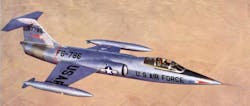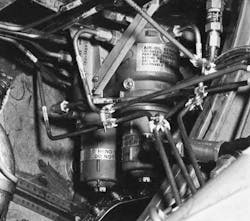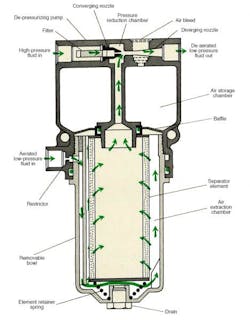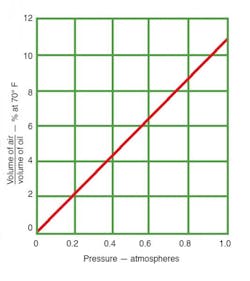Tried & True Ways of Dealing with Air in Hydraulic Fluid
In collecting information for my next series of blogs, I ran across another article from long ago that piqued my interest, and I think readers can learn a lot from it. It describes how air getting into the hydraulic circuit for steering an F-104 fighter aircraft caused erratic operation. More importantly, it explains what was done to correct the problem.
Once again, this article deomonstrates that even though hydraulics has made huge advancements in the last 50 years, we can still learn a lot from some of these classic articles from the archives of Hydraulics & Pneumatics. By the way, I also placed references to other classic aritcles dealing with aeration of hydraulic fluids in the Related Article box after the end of this article.
Separator de-aerates oil, stops shimmy on F-104 nose wheel
Two Lockheed engineers developed a new type of air extractor to overcome a problem that had bugged the steering-damping unit on the F-104 aircraft for years.
By Robert M. Livesey and Mark H. Ettinger
Symptoms typical of an aerated hydraulic system plagued the F-104 aircraft for many years. (To understand what fluid aeration is and how fluids become aerated, see the box, “How fluids become aerated.”) Aeration was caused by system components with built-in chambers and passages where free air (bubbles) collected when system fluid was saturated or at rest with no pressure acting on the fluid.
The steering-damping unit of the nose landing gear on the F-104 aircraft is a typical hydraulic component. It extracts energy from hydraulic fluid by restricting flow between two chambers and, thus, damps nose wheel oscillation. If the fluid is aerated, the energy extracted diminishes until it reaches a level where the damping energy is below the unbalancing force of the wheel, and shimmy sets in.
Several types of air extraction devices then available were tested over a span of years. Unfortunately, they were not effective in the pressure environment of the aircraft system. Finally, basic studies were undertaken. Theories were explored, which led to the construction and testing of a laboratory model of an air-oil separator that stopped the nose-wheel shimmy.
Unfortunately, bubbles get smaller with increasing pressure. The lowest pressure in the F-104 is about 30 psig. This pressure was far too high because even at this pressure the free air bubbles would be compressed and driven through the filter screen. Total bubble removal was not possible. The next logical step was to introduce an aspirator, which would reduce the pressure in the chamber so the bubbles would expand and not penetrate the filter screen.
It was at this stage that the scheme to use a jet pump (aspirator) to lower the pressure in the separating chamber was tried. By lowering the pressure acting on the fluid, large quantities of dissolved and free air were released and the filter screen barrier was able to separate the bubbles from the fluid.
Air Re-absorbed Quickly
During the development testing it was noted that fluid released of its air by the separator would quickly reabsorb air when left in an exposed container. The de-aerated fluid acted somewhat like a sponge. This phenomenon was proved very beneficial in bleeding complex systems such as that of the F-104. The most remote reaches of the system are bled effectively by circulating treated (de-aerated) fluid throughout the system, reabsorbing pockets of air. Nooks and crannies that would normally never get bled using conventional bleeding methods are easily cleared of air.
On F-104 aircraft, two separators — one for each hydraulic system — are in operation whenever the aircraft hydraulic system is used, either in flight or on ground test stand power. Extracted air is easily bled-off during ground servicing with a conveniently located pushbutton-operated bleed valve in each system that sequentially blocks jet pump flow and opens the air storage chamber to the atmosphere.
Sizing Separator to System
An air-oil separator can be designed to fit most hydraulic system requirements by varying the volume of pressurized flow, separating chamber and filter size, and servicing frequency.
The volume of separating flow and separating chamber vacuum pressure can be balanced by adjusting the size of the inlet restrictor. The jet pump should be sized according to the amount of pressurized flow that can be spared from the system and the amount of heat that the system can tolerate. (Pressure drop across the pump nozzle adds heat to the fluid.)
If an air-oil separator is considered during the early stages of system design, the separating filter can be integrated with system filtration requirements since the separator is ideally situated in a bypass loop of the system with relatively low flow rates and low return pressure.
Robert Livesey is a senior design specialist, Advanced Development Division, and Mark Ettinger is a senior design engineer, F-104 Project, Locklweed-California Co., Burbank, Calif. They are the inventors of this air-oil separator, which was developed in 1962 for the F-104.
Lockheed-California Co., has licensed exclusively the Seaton Wilson Mfg. Co., Burbank, Calif., to develop, manufacture, and sell these air-oil separators that use a jet pump to aspirate gases from liquids.
How Fluids Become Aerated
Air can enter a hydraulic system in many ways, and, according to Henry's Law, will be dissolved in a fluid in proportion to the pressure acting on the fluid. Thus, considerable quantities of air can be dissolved in a system that has a pressurized reservoir because the pressurizing media (air or a gas) is in direct contact with the fluid surface. Additional quantities of air may be introduced by aircraft servicing equipment, such as hydraulic ground test stands, which also use air-pressurized reservoirs.
When the system is at rest and unpressurized, air in excess of that which can naturally be dis solved at the zero pressure condition is released as free air.
Effects of Air
Air in a hydraulic system has many detrimental effects on both component and system performance. The more obvious symptoms of an aerated system are system oscillation, power loss, cavitation, increased fluid heat, response lag, foaming, and "spongy" controls. Loss of power and a "soft" system can be directly attributed to a decrease in the bulk modulus (greater compressibility) of the fluid because of an increasing air content.
Editorial Advisory Board
Charles H. Cannon Howard D. Davis
Lockheed-Georgia Co. General Dynamcis/Convair
Kenneth W. Dubois Grady Gilder, Jr.
Douglas Aircraft Co. LTV Aeronautics Div.
John W. Ruttle, Jr. Frank M. Ladnich
The Martin Co.. Grumman Aircraft Engineering Corp.
E. T. Raymond William W. Mayhew
The Boeing Co. Grumman Aircraft Engineering Corp.
This article was originally published in the January 1967 issue of Hydraulics & Pneumatics.
About the Author
Alan Hitchcox Blog
Editor in Chief
Alan joined Hydraulics & Pneumatics in 1987 with experience as a technical magazine editor and in industrial sales. He graduated with a BS in engineering technology from Franklin University and has also worked as a mechanic and service coordinator. He has taken technical courses in fluid power and electronic and digital control at the Milwaukee School of Engineering and the University of Wisconsin and has served on numerous industry committees.

Leaders relevant to this article:




